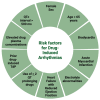Macrolide Antibiotic Mediated Cardiac Arrhythmias: Emerging Concepts and Clinical Implications
- PMID: 40564197
- PMCID: PMC12191034
- DOI: 10.3390/biomedicines13061478
Macrolide Antibiotic Mediated Cardiac Arrhythmias: Emerging Concepts and Clinical Implications
Abstract
The macrolide class of antibiotics are widely utilized in clinical settings for a broad range of bacterial infections and have additional roles as immunomodulatory agents. Although efficacious with a good safety profile overall, they have been associated with prolongation of the QT interval and development of the polymorphic ventricular tachycardia, Torsades de pointes (TdP). In a 2020 scientific statement, the American Heart Association (AHA) classified azithromycin, clarithromycin and erythromycin as QT-prolonging drugs known to cause TdP and the online database, CredibleMeds, that maintains a list of drugs known to cause QT prolongation classifies these drugs as having an increased risk of QT prolongation. The mechanism of this risk has been delineated to involve macrolide binding to and a blockade of delayed rectifier potassium channels that conduct rapid potassium current, Ikr, during repolarization, leading to prolonged repolarization and subsequent QT prolongation. Studies investigating this association have revealed variable results, with several suggesting that the risk of QT prolongation and TdP with macrolide use may be highly dependent on underlying patient risk factors and comorbidities. In the present investigation, we summarize current evidence on association of macrolide antibiotics, azithromycin, clarithromycin and erythromycin, with the development of QT prolongation and TdP, pathophysiology of and risk factors predisposing to development of these events, the role of implementation of strategies to reduce this risk and highlight emerging research.
Keywords: arrhythmia; azithromycin; clarithromycin; erythromycin; macrolide; torsades.
Conflict of interest statement
The authors declare no conflicts of interest.
Figures
Similar articles
-
Drugs for preventing postoperative nausea and vomiting in adults after general anaesthesia: a network meta-analysis.Cochrane Database Syst Rev. 2020 Oct 19;10(10):CD012859. doi: 10.1002/14651858.CD012859.pub2. Cochrane Database Syst Rev. 2020. PMID: 33075160 Free PMC article.
-
Antibiotics for the treatment of COVID-19.Cochrane Database Syst Rev. 2021 Oct 22;10(10):CD015025. doi: 10.1002/14651858.CD015025. Cochrane Database Syst Rev. 2021. PMID: 34679203 Free PMC article.
-
Macrolide antibiotics for bronchiectasis.Cochrane Database Syst Rev. 2018 Mar 15;3(3):CD012406. doi: 10.1002/14651858.CD012406.pub2. Cochrane Database Syst Rev. 2018. PMID: 29543980 Free PMC article.
-
Prophylactic antibiotics for adults with chronic obstructive pulmonary disease: a network meta-analysis.Cochrane Database Syst Rev. 2021 Jan 15;1(1):CD013198. doi: 10.1002/14651858.CD013198.pub2. Cochrane Database Syst Rev. 2021. PMID: 33448349 Free PMC article.
-
Drug-induced long QT syndrome in women: review of current evidence and remaining gaps.Gend Med. 2008 Jun;5(2):124-35. doi: 10.1016/j.genm.2008.05.005. Gend Med. 2008. PMID: 18573480
References
-
- Mehra I., Isaac S., Kundu S., Chahal K. Azithromycin-Induced Torsades de Pointes. Chest. 2021;160:A155. doi: 10.1016/j.chest.2021.07.175. - DOI
Publication types
LinkOut - more resources
Full Text Sources



